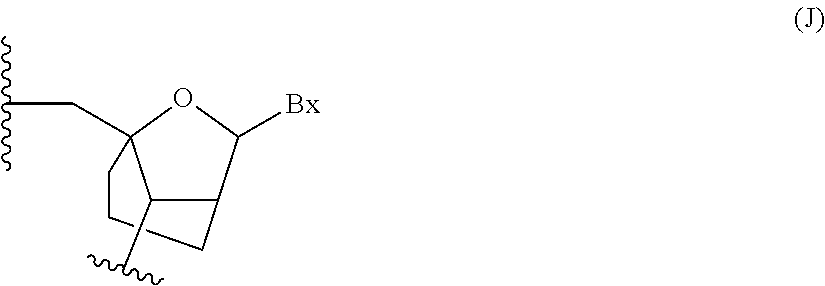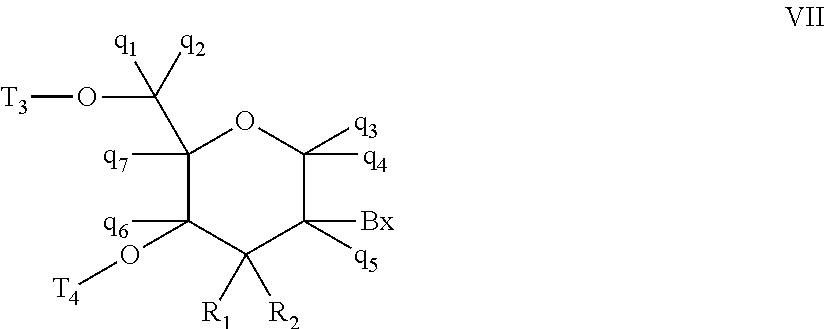Oligomeric compounds comprising bicyclic nucleotides and uses thereof
a technology of bicyclic nucleotides and compounds, applied in the field ofoligomeric compounds comprising bicyclic nucleotides, can solve the problems of cleavage of mrna and interfere with polyadenylation, and achieve the effect of reducing one or more symptom of disease or disorder
- Summary
- Abstract
- Description
- Claims
- Application Information
AI Technical Summary
Benefits of technology
Problems solved by technology
Method used
Image
Examples
example 1
Modified Antisense Oligonucleotides Targeting Human Target-X
[0393]Antisense oligonucleotides were designed targeting a Target-X nucleic acid and were tested for their effects on Target-X mRNA in vitro. ISIS 407939, which was described in an earlier publication (WO 2009 / 061851) was also tested.
[0394]The newly designed chimeric antisense oligonucleotides and their motifs are described in Table 11. The internucleoside linkages throughout each gapmer are phosphorothioate linkages (P═S). Nucleosides followed by “d” indicate 2′-deoxyribonucleosides. Nucleosides followed by “k” indicate constrained ethyl (cEt) nucleosides. Nucleosides followed by “e” indicate 2′-O-methythoxylethyl (2′-MOE) nucleosides. “N” indicates modified or naturally occurring nucleobases (A, T, C, G, U, or 5-methyl C).
[0395]Each gapmer listed in Table 11 is targeted to the human Target-X genomic sequence.
[0396]Activity of the newly designed gapmers was compared to a 5-10-5 2′-MOE gapmer, ISIS 407939 targeting human Ta...
example 2
Modified Antisense Oligonucleotides Comprising Constrained Ethyl (cEt) and F-HNAmodifications Targeting Human Target-X
[0397]Additional antisense oligonucleotides were designed targeting a Target-X nucleic acid and were tested for their effects on Target-X mRNA in vitro. ISIS 407939 was also tested.
[0398]The newly designed chimeric antisense oligonucleotides and their motifs are described in Table 12. The internucleoside linkages throughout each gapmer are phosphorothioate linkages (P═S). Nucleosides followed by “d” indicate 2′-deoxyribonucleosides. Nucleosides followed by “k” indicate constrained ethyl (cEt) nucleosides. Nucleosides followed by “e” indicate 2′-O-methythoxylethyl (2′-MOE) modified nucleosides. Nucleosides followed by ‘g’ indicate F-HNA modified nucleosides. “N” indicates modified or naturally occurring nucleobases (A, T, C, G, U, or 5-methyl C).
[0399]Each gapmer listed in Table 12 is targeted to the human Target-X genomic sequence.
[0400]Activity of the newly designed...
example 3
Modified Antisense Oligonucleotides Comprising 2′-MOE and Constrained Ethyl (cEt) Modifications Targeting Human Target-X
[0401]Additional antisense oligonucleotides were designed targeting a Target-X nucleic acid and were tested for their effects on Target-X mRNA in vitro. ISIS 403052, ISIS 407594, ISIS 407606, ISIS 407939, and ISIS 416438, which were described in an earlier publication (WO 2009 / 061851) were also tested.
[0402]The newly designed chimeric antisense oligonucleotides are 16 nucleotides in length and their motifs are described in Table 13. The chemistry column of Table 12 presents the sugar motif of each oligonucleotide, wherein “e” indicates a 2′-O-methythoxylethyl (2′-MOE) nucleoside, “k” indicates a constrained ethyl (cEt) and “d” indicates a 2′-deoxyribonucleoside. The internucleoside linkages throughout each gapmer are hosphorothioate (P═S) linkages. All cytosine residues throughout each oligonucleotide are 5-methylcytosines.
[0403]Each gapmer listed in Table 13 is ta...
PUM
| Property | Measurement | Unit |
|---|---|---|
| size | aaaaa | aaaaa |
Abstract
Description
Claims
Application Information
 Login to View More
Login to View More - R&D
- Intellectual Property
- Life Sciences
- Materials
- Tech Scout
- Unparalleled Data Quality
- Higher Quality Content
- 60% Fewer Hallucinations
Browse by: Latest US Patents, China's latest patents, Technical Efficacy Thesaurus, Application Domain, Technology Topic, Popular Technical Reports.
© 2025 PatSnap. All rights reserved.Legal|Privacy policy|Modern Slavery Act Transparency Statement|Sitemap|About US| Contact US: help@patsnap.com



